Services on Demand
Article
Indicators
Related links
-
 Cited by Google
Cited by Google -
 Similars in Google
Similars in Google
Share
South African Journal of Agricultural Extension
On-line version ISSN 2413-3221
Print version ISSN 0301-603X
S Afr. Jnl. Agric. Ext. vol.42 n.1 Pretoria 2014
An enquiry into the prospects of mobile telephone for agricultural information delivery in Ondo State, Nigeria
Fasina O. O.I; Odefadehan O. O.II
IDept. of Agric. Extension & Communication Technology. Federal University of Technology, P.M.B 704 Akure, Ondo State, Nigeria
IIDept. of Agric. Extension & Communication Technology. Federal University of Technology, P.M.B 704 Akure, Ondo State, Nigeria
ABSTRACT
Extension is essentially a communication process whereby various participants are linked together and exchange information to enhance their potential and standard of living. It makes use of different channels through which this information could be passed across of which mobile phones constitute one of the contemporary channels. This study was carried out to investigate the prospects of mobile telephone in dissemination of agricultural information in Ondo state, Nigeria. A multistage sampling technique was used for the study, both descriptive and inferential statistics were used to analyse results. The study revealed that the majority (85%) of the respondents in the study area was male. Those with primary education and above were 60.2%. Majority accessed information through friends (79.6%) and radio (75.2%). Mobile phones were used by 81.4% of which Nokia was the most common brand of handsets (57.3%). The various functions on respondents' phones include browsing facilities (31.9%), camera (37.2%), video player and recording (31.9%), blue tooth (30.1%) and radio (45.1%). Their ability to operate these functions was low; about 90% cannot use MP3 on their phone. Majority (71.7%) were ready to purchase phones with multimedia facilities and to receive extension messages through phones (93.8%). There was a significant but negative correlation relationship between age of respondents and their operational proficiency of mobile phones (r= -0.50), but positive relationship exists between education of respondents and operational proficiency of mobile phone (r= 0.60).Government should go into partnership with communication outfits to provide cheaper phones at subsidized rate as well as develop agricultural information packages to be used on mobile phones.
Keywords: Mobile phones, agricultural information, global system for mobile communication (GSM), telecommunication, extension agent, rural
1. INTRODUCTION
Nigeria is a country where a sizeable percentage of its population is involved in agriculture and agricultural related activities. Most of these people involved in agriculture live in rural areas where there is inadequate infrastructure like telecommunication, roads, pipe-borne water, electricity, health facilities just to mention a few. The rural people in Nigeria had been cut off from their urban counterparts as a result of bad roads and worse still no telecommunication means, until 2001 when Global System for Mobile communication (GSM) was introduced. The rural people who were not accessible because of bad roads are now accessible to an extent through mobile communication in Nigeria. Mobile telephony is without doubt one of the most explosive developments ever to have taken place in the telecommunications industry.
With the revolution of Global system for mobile communications (GSM) in 2001 into the telecommunication industry, it has transformed lives and the economy of the nation as a whole through the improvement of human capital, rural environment sustenance, social networking and heighten political awareness (Malecki, 2003). A mobile phone is an electronic device used for mobile telecommunications over a cellular network of specialized base stations known as cell site, it is also the provision of telephone services to phones which may move around freely rather than stay fixed in one location.
Today, mobile phones are used to provide information to the farmers and rural residents through SMS and multimedia-supported systems. In many rural areas, this has been made possible through both public and private sector initiatives. According to Wei and Zhang (2009), mobile telephone use offers real benefits to rural residents in the area of connectivity to the outside world as well as reduced unnecessary commuting to urban centres. From a socio-economic point of view, mobile telephones effectively reduce the "distance" between individuals and institutions, making the sharing of information and knowledge easier and more effective. Mobile telephone offers some unique rural opportunities. For example, mobile telephones provides a direct global communication channel to rural communities, extending the impact of established rural media, making local content available and making rural services (i.e. agricultural extension) more efficient and cost-effective.
2. STATEMENT OF THE PROBLEM
In Nigeria, the use of mobile phones has witnessed an upsurge in recent years despite the persisting problem of access, connectivity, literacy, and costs (Adeniji, 2010). The development of infrastructure especially in the area of telecommunication brings with it both opportunities and challenges. Agricultural extension should not be left behind in these developments as the need to improve the lifestyle of the farmers and reduce rural poverty is becoming more important.
According to Omotayo (2005), a number of development in many developing countries in recent times are shaping the future of extension services and setting the stage for the adoption of mobile telephones, evaluation research has however demonstrated that training and visiting system being used in Nigeria with its conventional methods of information dissemination is not able to meet users demand as information is not demand driven but based on availability of new research finding and innovations.
Furthermore, the T and V system has demerits that mobile phone can be used to tackle for example information dissemination through mobile phones will be cheaper than the usual T and V system. With increasing need for up to date information to meet ever increasing need of extension clientele which goes beyond just agriculture in today's world to include issues on climate change, HIV, food insecurity, environmental protection; therefore there is need to use cheaper and more efficient methods to disseminate information. It is therefore necessary to assess the readiness and practicality of farmers of the Nigerian agricultural extension system to join mobile phone users in agricultural extension delivery. It is to this end that this study is being carried out to achieve the objectives stated in the next section.
3. OBJECTIVE OF THE STUDY
The general objective of the study is to make an enquiry into the prospects of mobile telephones for agricultural information delivery in Ondo state. The specific objectives are to:
- examine the socio-economic characteristics of the respondents.
- investigate the awareness of farmers on mobile phones.
- determine farmers' ability to operate mobile phones and their competency level on the use of phone multimedia facilities.
- determine respondents' expenditure on use of mobile phone airtime.
- investigate the usefulness of mobile phones on agricultural information delivery to the farmers.
4. JUSTIFICATION OF THE STUDY
Information management plays a major role in today's world of information abundance and outflow. Information technologies represent means of distributing information and knowledge in much faster and efficient way (Krishan, 2000). Therefore, this study will help to know the prospect in the usage of mobile telephones among the farmers in Ondo state as a tool of information technology. It will help determine what must be done to help them in line with other rural farmers in countries like India who have exploited the use of mobile phones in getting relevant information for their farming activities. According to Fafchamps & Minten (2011), the Indian farmers have benefited from Reuters Market Light (RML) SMS phone messages on market price, weather updates, and crop advisory information.
5. RESEARCH METHODOLOGY
Study Area
The study was carried out in Ondo state which is one of the 36 states of the federal republic of Nigeria. Eighty percent of the population is engaged in agriculture and agricultural related activities like processing, storage and marketing of agricultural products. The state has eighteen local government areas. A multistage sampling technique was used to select 113 farmers in the study area. The first stage involved the random selection of Akure South and Ifedore Local Government area from the eighteen local government areas in the state. The second stage was a proportionate and random selection of six villages in Akure south and four villages in Ifedore Local Government based on the total numbers of villages in each local government area. The third stage involved random selection of 15 farmers from each of selected villages, thereby giving a total sample size of 150. A total of 150 farmers were interviewed however only 113 interview schedule were usable for the study.
The data collected was subjected to descriptive statistical analysis such as frequencies, mean, and percentages which was used to analyse socio-economic characteristics of the respondents and result is presented in table. Chi-square was used to analyse the relationship between the socio-economic characteristics of farmers and their competence level of use of mobile phones. Also, inferential statistics such as Correlation Coefficient was used to assess the significance of the explanatory variables on the revenue.
6 RESULTS AND DISCUSSION
6.1 Socio-economic characteristics of respondents
Table 1 shows that 18.6% of the respondents were into livestock farming, majority of the respondents in the study area planted cash crops (83.2%). While arable crops such as maize, cassava, and yam were planted by 78.8%, this shows that the respondents practiced mixed cropping in the study area.

According to Table 2 the age distribution of farmers in the study area reveals that majority of the respondents (46%) fell in the age group of 51-70 years, just 5.3% were below 30 years, about 25.67% were between 31-50 years, 20.35% between 71-90 year while 2.65% above 90 years. The mean age was 58.69 years. This average age shows that the elderly still dominates farming. The younger ones have migrated to urban areas in search of greener pasture. This view is supported by Vargas-Lundius (2011) who stated that "Many prefer to migrate to urban centres or even to other countries in the hope of finding decent jobs. Too often they discover quickly that they lack the skills, training and networks to compete in already saturated job markets."
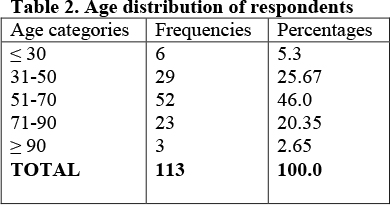
From Table 3, high percentages of the respondents (85%) were male, while female constituted about 15% of the population. This implies that farming is a male dominated occupation in the state. This is similar to the findings of Adeyinka. (2007), in which majority of the respondents in their study on perceptions of GSM in rural Nigeria were male. Similarly Arifalo & Daramola (2006) in their study of rice farmers in South West Nigeria has males accounting for greater percentage of the respondents.

It could be seen from Table 4 that most of the respondents (84.1%) were married, This percentage of married respondents is similar to the findings of Ugwuja et. al. (2011) where 88.7 percent of farmers sampled in Ekiti State were married. 2.7% were divorced, 7.1% widowed, 0.9% separated while only 5.3% were single. Responsibilities/obligations are attached to being married therefore a married person is assumed to be responsible. Married farmers also have the advantage of access to family labour from his household; these could be an important factor that responsible for most farmers being married. It can thus be said that farming is an occupation mainly practiced by married people.
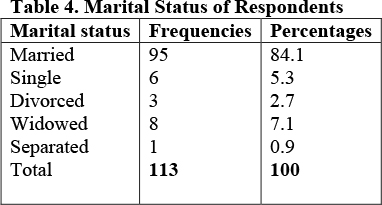
From Table 5, majority of the respondents (52.2%) have household size of 1-5 members, 43.4% have 6-10 household members while the remaining 4.4% have between 11-15 members. Since 52.2% of the respondents have a household size between 1-5 members, family labour will be limited in use. The mean household size is 5.47. This shows that the days of large family size by farmers is fast disappearing and the farmers are now more conscious of having a family size they can cater for.
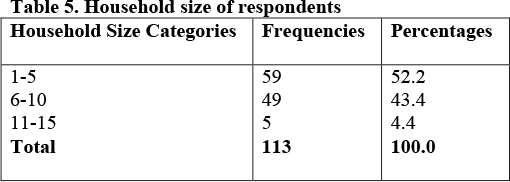
Table 6 reveals that the dominant religion among the farmers in the study area was Christianity. About 82 % of the respondents were Christians, while 15% were Muslims. The traditional believers were just 2.7 % of the respondents.
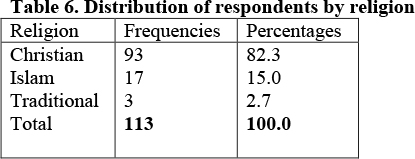
The result in Table 7 shows that 39.8% had no formal education; this is consistent with Oladosu & Okunade (2006) whose study showed that 36% of respondents had no formal education. The respondents that had primary education were 27.4%, 12.4% had secondary education, 8.0% had OND, and 5.3% had HND while 7.1% had B. Sc. & above. This indicates that majority of the respondents were educated which will make communication and interaction easy during dissemination of agricultural information.
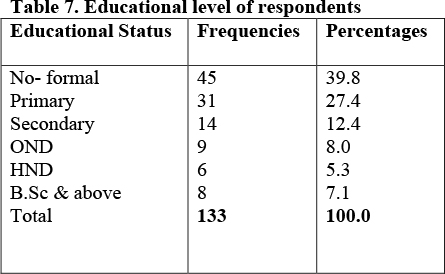
From Table 8 it was revealed that 58.4 % were able to read English language, 56.6% can read Yoruba while 5.3% can read Igbo out of the 60.2 % that are educated among the respondents, implication of this is that these group of farmers that can read will be able to access information on their phones whether in English or Yoruba language. This gives a bright chance to information dissemination through mobile phones by agricultural extension services.
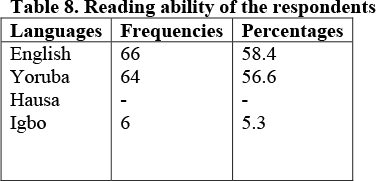
From Table 9, 59.3% of the respondents has farming as their major occupation while 40.7% of the respondents had non-farming job as their primary occupation and this may be as a result of high risks and uncertainty associated with agriculture. This finding is contrary to Oguntade et. al 2010 in which their study of minisett yam farmer in Oyo state put the percentage of respondents whose primary occupation is farming at 16.7%. A small percentage of this (15%) were civil servants, 11.5 % of the respondents were artisan while 14.2% were petty traders. This is a pointer that the rural people are enterprising and are involved in various activities in order to earn a living.
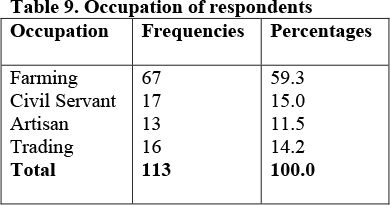
6.2 Mobile phone usage by respondents
Percentage of respondents that have mobile phone in the study area as shown in Table 2 was 81.4% while 18.5% of the respondents did not have mobile phone at the time when data was collected. Reasons for not having mobile phone were due to misplacement of such phone and financial constraints.
It was observed that ten types of mobile phones were mostly used by respondents in the study area. They are; Nokia, Techno, Motorola, Sagem, Intel, J star, multilink, Samsung, Sony Ericson, and Visafone. About 51.3% of the respondents use Nokia, while 9.7% use techno, Motorola (2.7%), Intel (1.8%), J star (2.7%), Multilink(0.9%), Samsung (4.4%), Sony Ericson (3.5%), Sagem (1.8%), Visafone (2.7%). This indicates that the types of phone used by the respondents is not limited to a particular brand but rather it cuts across various types of mobile phone brands available in the market, though Nokia was the most popular brand among them as shown in Table 11.
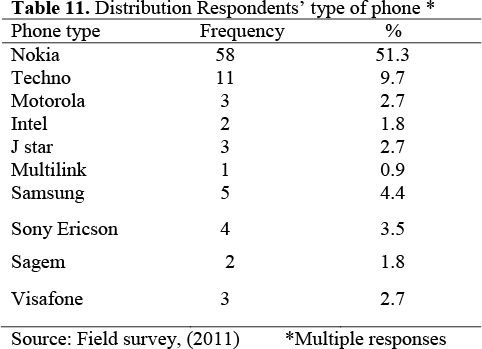
6.4 Functions on respondent's phone
From Table 12, the various functions on the respondents phone include: camera (62.8%), blue tooth (30.0), browsing (31.9%), MP3 (21.2%), video recorder (33.6%), memory card (26.5%), video player (31.9%), radio (45.1%). Among these functions on the phone which allow farmers to have access to information; radio was found to have the highest percentage of 45.1%, meaning that these farmers will have access to several organised instructional agricultural programmes if transmitted on radio. If information is placed on websites, 31.9 % of the farmers have potential to access them and 36.3 % will be able to send pictures to extension organisation/ research institutes. Furthermore, 31.9 % have the potential to access video that could be sent to their phones. Respondents that have the potential to store diverse kinds of information on the memory card of their phone stood at 26.5%.
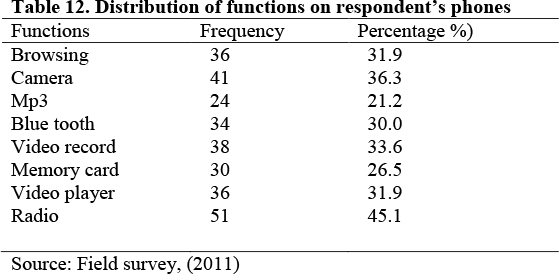
6.5 Major Network Used by Respondents
From Table 13, it was observed that six mobile phone service providers out of the nine available in Nigeria telecommunication industry were available in the study area, they are: MTN (61.9%), Globacom (10.6%), Visafone (2.7%), Etisalat (8.8%), Multilink (0.9%), and Airtel (8.8%). MTN has the largest share of 61.9% and some of the respondents used two or more networks depending on the service available at their various locations. Implication of this is that MTN could be approached to help in reaching farmers with agricultural news and other incentives.
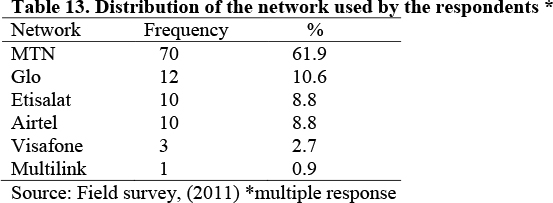
6.6 Operational proficiency of mobile phone by respondents
Table 14 shows the levels at which the farmers were able to use various functions on their phones. It was shown that video player and recording can be used by 15.9%, camera (20.4%), radio (23.9%), MP3 (8.0%), browsing (13.3%), and Bluetooth (17.7%). It was discovered that most of the people that are able to operate this functions are the farmers with OND qualification and above. Therefore, seminars and operation video clips could be produced to teach other farmers how to operate these functions which will enable them to have access to various agricultural innovation information at their various locations and invariably positively affect their agricultural productivity.
6.7 SMS reading proficiency
Table 15 revealed that 46.0 % of the respondents were able to read very well, 9.7 % can rarely read while 44.2 % were not able to read at all due to eye site problem or illiteracy. Since majority of the farmers (55.7%) are able to read SMS, extension agent should take advantage of this opportunity by sending bulk messages to this group of farmer on farm level improvement and also organise training programmes for others in other to join the train of new breed of farmers who will together enhance agricultural productivity.
6.8 Expenditure on airtime per week
From Table 16 the highest percentage , representing 58.5% of the respondents used between ₦101- ₦500 airtime weekly followed by 23.9% that use less than or ₦100 airtime per week, 3.6% and 3.5% of the respondents who are majorly the contact farmers in the study area use ₦1,001- ₦1,500 and ₦1501-₦2000 airtime weekly, respectively.
6.9 Farmer's interest in receiving agricultural information through mobile phone
From Table 17 majority (93.8%) of the respondents were willing to receive agricultural information through mobile phones while only 6.2% were not willing, this implies information dissemination through the use of mobile phones has great prospects.

6.10 Information Need Assessment
From Table 18, majority of the respondents were willing to receive information on their health (92.0%), family affairs (87.6%) environment (92.9%), climate change (91.2%), and other available information (14.2%). All these will enable the farmers to have a vast knowledge about issues arising in the study area. The combination of these categories of information will improve their productivity. Healthy farmers are productive farmers; therefore access to health information will go a long way at improving their agricultural activities (Odefadehan, 2012)
6.11 Current Sources of Agricultural Information
From Table 19, it was revealed that majority of the respondents had access to agricultural information through friends and individual contact (79.6%). Radio was source of information to 75.2% of the respondents while 74.3% of them use television as source of agricultural information. A reasonable percentage (64.6%) of the respondents receives agricultural information through farmers' meeting. Agricultural Extension agents were the source of agricultural information to 21.2%, this is a reflection of inadequate supply of extension personnel in the state. This state of inadequacy of extension agents is supported by Agbamu (2005); who stated that "major problem to extension service in developing countries is the inadequate number of extension workers". In the same vein Bello and Obinne (2012) opined that one major constraint in information dissemination was the limited number of trained extension workers in Nigeria. Mobile phones are yet to be a source of agricultural information to the respondents in the study area; this therefore require urgent attention of all stake holders in the agricultural sectors (farmers, the three tiers of government and NGOs) to harness the use of mobile phones as a channel of agricultural information dissemination. The use of mobile phones will go a long way to transform the agricultural situation of the study area and the nation as a whole.
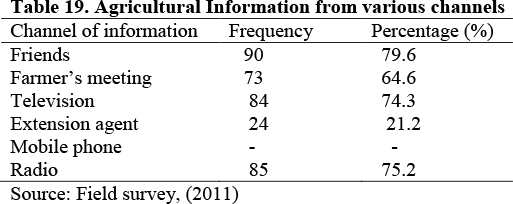
6.12 Correlation Relationships among Selected Personal Characteristics of Respondents and Mobile Phone Operational Proficiency.
Table 20 reveals that there is a significant but negative relationship (r= -0.49) between the age of respondents and operational proficiency of mobile phone by the farmers, this means the older the farmer the lesser their proficiency in operating their mobile phones. The older farmers may not be able to use mobile phones proficiently as the younger ones will do. The implication of this is that for the agricultural sector to effectively benefit from the prospects in the use of mobile phones, youths should be encouraged to participate in farming. Education of the respondents is positively correlated (r= 0.6) with their phone use The higher the education of the farmers the better their ability to make use of their mobile phones. In addition, the higher the frequency of mobile phones usage the higher the farmers' proficiency in their use of mobile phones (r= 0.87). This could be because the more often the use of phone; the more the mastery and familiarity with it. This trend is also similar to the amount spent on airtime per week; the higher the amount expended per week the higher the proficiency of use. Activities involved in the use of the air time from loading the airtime to its use in either making calls, sending text messages will bring about better familiarity and thus higher proficiency in the use of mobile phones by the respondents.
6.13 Relationship between socio-economic characteristic of farmers and their Operational Proficiency.
From Table 21, the tabulated Chi - square value for marital status, language readability and language spoken are less than their calculated values; hence there is significant relationship between respondent's socio-economic characteristics (marital status, language spoken and language read) and their operational proficiency of mobile phone. The respondents with higher level of education could be assumed to be in the category of those who are able to read and write English language in addition to their local language thus causing the significance. The marital status being significant could be as a result of the spouse teaching each other how to use the functions of the phone. Chi - square calculated values for sex and religion are less than their tabulated value. Therefore sex and religion as revealed in table 14 are not significant with proficiency of mobile phone use at 0.05 level of significance.
7. CONCLUSION AND RECOMMENDATIONS.
The study has revealed that respondents are still dependent on the conventional sources of information for their agricultural activity. Despite their ownership of mobile phones with various functions, many are yet to take advantage of such facilities. Though their phones are currently under utilized there is a very great willingness on their part to utilize their mobile phones as a source of agricultural information delivery. This reveals the great prospects for agricultural extension to make use of mobile phones for information delivery. In addition, the farmers who do not have phones are willing to purchase so that they too can be part of the revolution of agricultural information delivery through mobile phones when the time comes.
Based on the findings of the study, the following are recommended to ensure an improvement in dissemination of information in the study area:
1 Government should go into partnership with communication outfits to provide cheaper phones at subsidized rate as well as develop agricultural information packages to be used on mobile phones.
2 There should be an appropriate policy by the government that will directly encourage the use of mobile phones that have applicable functions by the farmers in the state to enhance information dissemination to the farmers by various extension organisations.
3 Government and non-governmental agricultural institutions should conduct regular training for farmers on the proper use of various functions on mobile phones. This will update their knowledge, expose them to current facilities on phones and empower them to make proper use of them.
4 Government should organise adult literacy programmes for the illiterate farmers to improve their reading and writing competency which will in turn enable them use various functions on their phones and contribute to the overall development of the agricultural sector.
5 There should be partnership with major GSM carriers to have a platform on their network where farmers can access relevant information on agriculture free or at token i.e information on weather, health, market prices, outbreak of diseases, and advisory database among others.
REFERENCES
ADENIJI, O. B (2010): Potentials of Information and Communication Technologies for Poverty Alleviation and Food Security. Journal of Agricultural Extension Vol. 14 (2). [ Links ]
ADEYINKA, T. (2007): Stakeholders' Perceptions of the Impact of the Global System for Mobile Communications on Nigeria Rural Economy: Implications for an Emerging Communications Industry. Journal of community informatics Vol. 3, NO 4. Accessed May 2013 from http://ci-journal.net/index.php/ciej/article/viewArticle/379 [ Links ]
AGBAMU, J. U. (2005): Problems and Prospects of Agricultural Extension Service in Developing Countries. Agricultural Extension in Nigeria.: AESON, pp. 159 - 169. Ilorin [ Links ]
ARIFALO, S. F. & DARAMOLA, A. G. (2006): Competitiveness and Efficiency of rice Farming System in South West of Nigeria. Federal University of Technology Akure: Accessed May 2013 from FUTA Repository at http://hdl.handle.net/123456789/1349 [ Links ]
BELLO, M. & OBINNE, C. P. O. (2012): Problems and Prospects of Agricultural Information Sources Utilization by Small Scale Farmers: A Case from Nasarawa State of Nigeria. 3(2): 91-98 Journal of Communication. Kamla-Raj Publications, India. [ Links ]
FAFCHAMPS, M. & MINTEN, B.(2011): Impact of SMS-Based Agricultural Information on Indian Farmers Accessed May 2013 from Oxford University ,United kingdom Repository at http://users.ox.ac.uk/~econ0087/rml.pdf [ Links ]
KRISHAN, J. B. (2000):"Information Communication Technology (ICTs) for Rural Development and Food Security". Accessed May 2013 from http://www.aptsec.org. [ Links ]
MALECKI, E. J. (2003). Digital Development in Rural Areas: Potentials and Pitfalls. Journal of rural studies, 19: 210-214.(PDF) Measuring the Information Society: The ICT Development Index. International Telecommunication Union. 2009. p. 108. ISBN 9261128319. Retrieved 2009-06 27. [ Links ]
ODEFADEHAN, O. O. (2012): Determinants of Adoption of Selected Public Health Intervention Strategies by Rural Farming Household in Ondo State, Nigeria. Unpublished Ph.D Thesis, Federal University of Technology, Akure. [ Links ]
OGUNTADE A. E, THOMPSON O. A., & IGE T. (2010): Economics of Seed Yam Production Using Minisett Technique in Oyo State. The Journal of Field Actions Vol. 4 (2010) Nigeria. [ Links ]
OLADOSU, E. O & OKUNADE E .O (2006). Perception of Village Extension Agents in Disseminating Agricultural Information in Oyo Agricultural Zone of Oyo State, Nigeria. Journal of Social Science. 12(3): 187-191. [ Links ]
OMOTAYO, A. M. (2005): Information Communication Technology (ICT) and Agricultural Extension: Emergency Issues in Transferring Agricultural Technology in Developing Countries. In: S.F Adedoyin (Ed): Agricultural Extension in Nigeria. Agricultural Extension Society of Nigeria. Ilorin Pp 24-46 [ Links ]
UGWUJA, V. C.; ADESOPE O. M., ODEYEMI T. J., MATTHEWS-NJOKU E. C., OLATUNJI S. O.,IFEANYI-OBI, C. C. & NWAKWASI R. (2011): Socioeconomic Characteristics of Farmers as Correlates of Fertilizer Demand in Ekiti State, Southwest Nigeria: Implications for Agricultural Extension. Greener Journal of Agricultural Sciences Vol. 1 (1), pp. 048-054 [ Links ]
VARGAS-LUNDIUS, R. (2011): Feeding future generations: Young Rural People Today -Prosperous, Productive Farmers Tomorrow. Proceedings of the Governing Council High-Level Panel and Side Events of the Thirty-fourth Session of IFAD's Governing Council. [ Links ]
WEI, L. & ZHANG, M. (2008). The Adoption and Use of Mobile Phone in Rural China: a case study Hubei, China. Telematics and informatics, 25: 169-186. [ Links ]
 Correspondence:
Correspondence:
royalambfuta@gmail.com














